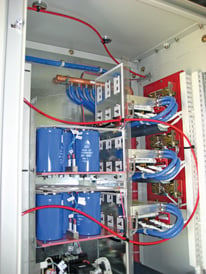Wind farms located offshore are difficult to access and harder to repair. Consequently, the financial impact of offshore turbine fires can be much more significant than onshore incidents. It is vital that this is factored into risk management plans at a time when the US has set a target of reaching 30GW of offshore wind capacity by 2030, a goal that will cost tens of billions of dollars to achieve.
The increased cost of fires in offshore turbines is due to a number of factors including:
- Offshore wind projects being more complex to build than those onshore
- The installation of offshore wind turbines in deep waters being more challenging and therefore more costly
- Offshore wind farms are more difficult to access than those onshore so therefore take longer to maintain and repair, which ramps up costs
How Much More Costly Are Offshore Wind Farm Fires?
Industry experts say it is likely the cost of an offshore turbine fire will be double that associated with a fire in an onshore turbine. In the view of specialist energy consultancy, Coalesce Management Consulting, the costs associated with onshore wind farms are “significantly cheaper, sometimes costing half the price of an offshore wind farm.”
This means that replacing an individual offshore turbine damaged by fire will cost considerably more than replacing an onshore turbine. The bad news is that replacing an individual onshore turbine damaged by fire is becoming increasingly expensive, costing up to $9 million with 12-18 months of expected down time while a replacement turbine is secured. We can anticipate that a fire in an offshore turbine will incur costs significantly higher than that.
Why Offshore Turbine Fires Present Bigger Challenges Than Those Onshore
When a fire breaks out in a wind turbine, it is vital that the fire is tackled as quickly as possible. This is because, in only a few minutes, a faulty electrical component or an overheated gearbox can ignite a fire that leads to the total destruction of the turbine.
This presents a significant challenge in the case of onshore wind turbines that are in remote locations – and which could be more than 80 meters above the ground – because local fire departments are unlikely to reach the fire at all and will instead focus on mitigating the fire damage and stopping it from igniting the surrounding area. Imagine then if the wind turbine is situated out at sea, the challenges of extinguishing the fire are greatly exacerbated.
Offshore Turbines More Susceptible to Damage
As already highlighted, offshore wind turbines pose bigger maintenance-related challenges than onshore turbines, yet fire risk is no less of a threat. Furthermore, higher wind speeds and the harsh corrosive environment at sea mean offshore turbines are more susceptible to damage than those onshore.
In harsh offshore environments, corrosion is a constant risk to the structural integrity of substations, foundations and turbine tower segments, according to wind engineering services company, CWind. Given that offshore wind turbines are more likely to be in a state of structural degradation than those onshore, a wind turbine fire is likely to cause more damage than a fire in an onshore turbine.
Due to the increased risk of structural damage, offshore turbines need more frequent maintenance repairs – these repairs are not only expensive, but also difficult to carry out in a timely manner because of weather and sea conditions. Consequently, these additional challenges make the presence of faulty electrical components – which can cause fires – more difficult to immediately address in offshore turbines, thus the risk is increased.

How to Reduce Offshore Wind Farm Fire Risk
In order to reduce the risk of fire at your offshore wind farm, conducting an effective fire risk assessment (FRA) should be a priority. An FRA will limit potential damage to your offshore wind assets and mean you won’t incur millions in costs replacing turbines located at sea. Once a fire risk assessment is completed, the results should be shared with all stakeholders including colleagues responsible for personnel safety, your operations team and your finance team, as well as external providers of finance and insurance providers.
How Technology Reduces Offshore Fire Risk
Technologies that can be used for fire protection in offshore wind turbines include fire detection, arc flash detection, and condition monitoring systems. While most technologies focus on fire prevention or detection, only fire detection and suppression systems mitigate fire damage once a fire has started. Firetrace systems target specific ignition sources in the wind turbine. This allows a flexible, modular approach to fire protection that can be customized for different turbine makes and models.

